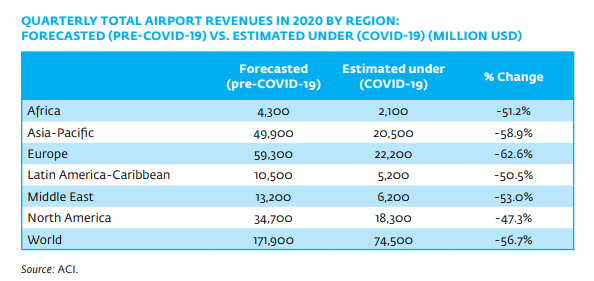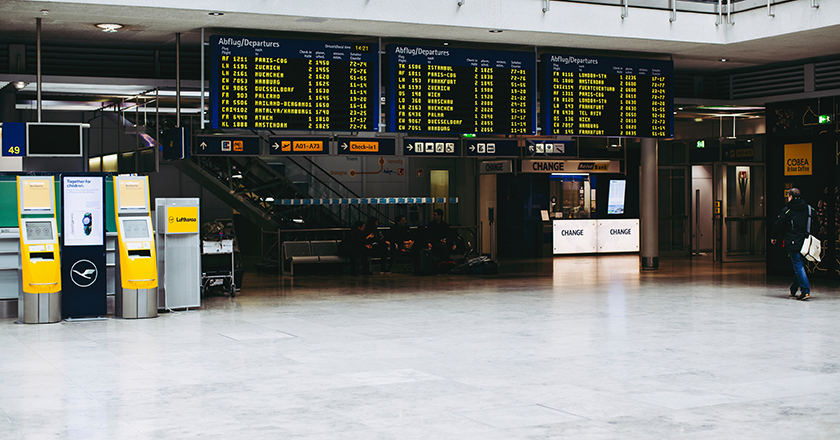The COVID-19 pandemic has touched every part of our society. The economy, and the markets and businesses within it, have been forced to change—or radically transform—to stay afloat during this time.
Aviation will be an industry that sustains the significant losses from the pandemic. The pandemic has left a big mark on the industry; while air travel may be up from the initial days of the pandemic, it isn’t nearly the levels seen before the pandemic.
The Impact of COVID-19 on Aviation
Why the aviation industry has been hit so hard by the COVID-19 pandemic isn’t hidden. Airports and airlines are the top choice for long-distance travel for many people. With lockdowns and fears of the coronavirus almost everywhere, most people can’t travel, or simply don’t want to.
Airports Council International (ACI) estimated that total revenue for airports across the world would fall by over 50% globally, and 50% across almost all of the major regions of the world.

Ian Petchenik, for flightradar24.com, compiled early data of the initial air traffic slow down. From March to April, flights across the globe fell significantly. Most areas saw at least 50% less flights, while some, like India, ceased flights almost entirely.
As the pandemic continues, the industry will most likely continue to see less demand for air travel. This means less revenue for both airlines and airports into 2021. Luckily, this isn’t a completely unprecedented trend for airports. The events of 9/11 and the SARS outbreak in 2003 caused similar fears about air travel and revenue reductions for aviation. COVID-19, however, will be an extended event, and have a more lasting impact than the previously mentioned disasters.
Being Flexible
Airlines and airports, while both in the aviation industry, are two separate entities working together to provide air travel. But the COVID-19 pandemic is necessitating extreme transformations in business and splintering industries like aviation to break their closely knit connections and rethink their operations entirely.
Airlines and airports, then, will each have their own wholly unique sets of challenges to face. Each deserves their own spotlight, so we’ll focus on the airport for the rest of this discussion.
One of the first facets of airport administration and operations that needs to be addressed is the existing relationships airports may have with airlines. Air travel presents a lot of opportunities for COVID-19 to spread; this includes in the airport, in the terminals, while boarding, and during the flight. Increased cooperation between the parties will be necessary to ensure social distancing and other health guidelines can be met and help prevent more individuals from contracting COVID-19.
Airports can also consider reducing the costs airlines incur for operating out of an airport. Because revenues are down, and will be for some time, this will alleviate some of the financial strain airlines are facing and allow them to operate with more freedom.
All of this isn’t to say that airports will still thrive through the pandemic, however. Airports themselves may need assistance, and especially smaller ones with smaller margins. These airports may want to explore options with their local governments, such as reducing airport taxes or asking for financial assistance. Costs can also be cut on the airfield operations side. Less air traffic means less runways are being used. Airports, additionally, can close some runways and other pieces of the operational infrastructure to cut costs and save money.
Adapting for the Long Term
The pandemic is a long-term event. Even if the pandemic were to end in a few weeks or months, airports would need some months after to recover.
International Finance Corporation has estimated that 18 months will pass before airports start seeing the traffic levels they did before the pandemic started. Some estimations go as far to say it may be 24 months.
Airport administrators will also need to implement more processes and procedures that help mitigate the risk of infection within their airports. Queues will need to be adjusted to accommodate social distancing and regular sanitization and cleaning rounds must be implemented. Terminals will also need to find a way to limit capacity in a way that allows travelers to distance themselves. Airports are very high traffic areas, necessitating the extreme caution airport administrators will need to take with their facilities.
Responding to the Pandemic
The circumstances of the pandemic, and the loss in revenue aviation is experiencing, will force airports to drastically alter their operations for the next year (or possibly longer). Airports will need to put together a long-term response plan for COVID-19 to ensure they can make operations during this crisis smoother.








